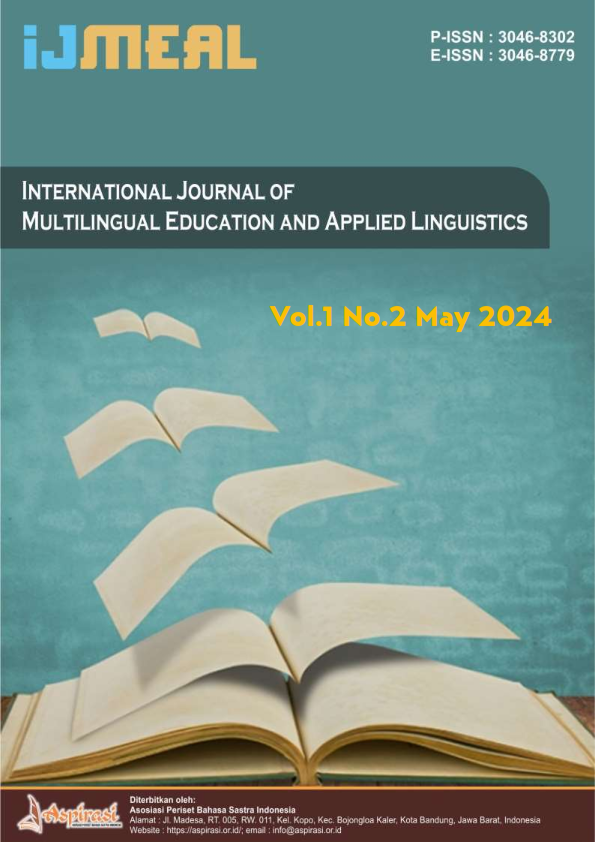Increasing Digital Literacy In Education: Analysis Of Challenges And Opportunities Through Literature Study
DOI:
https://doi.org/10.61132/ijmeal.v1i2.18Keywords:
Digital Literacy, Education, Challenges and OpportunitiesAbstract
By conducting literature research, this research aims to evaluate the difficulties and prospects in increasing digital literacy in education. In today's digital era, digital literacy is becoming increasingly important. The ability to understand, use and participate in digital environments is essential. However, the development of technology and its use in education also raises complex problems. Literature analysis was carried out to identify the main problems faced by students and teachers in improving digital literacy. The results of the analysis show that some of the main problems include the pace of change in digital technology, lack of access to technology, inappropriate curriculum, lack of teacher training, and inequality. On the other hand, there is a huge opportunity to improve digital literacy. This can be achieved through developing a curriculum that is integrated with technology, increasing accessibility to digital infrastructure and devices, and ongoing training for educators. A better understanding of the complexities of difficulties and opportunities in improving digital literacy among students and educators is gained from this research. It is hoped that this research will make a positive contribution to the continued progress of education in the computer and internet era because these findings can help create more efficient educational policies and teaching strategies that take advantage of developments in digital technology.
References
Ali Musri Semjan Putra, K. E. S. (2022). Sekuntum Nasehat Untuk Para Wanita Pembahasan Kitab Kitabul Mar’ah Durusul Mar’atul Muslimah. JPKM STIES Imam Asy Syafii Pekanbaru, 1(11), 1–10.
Annur, C. M. (2022). Ada 204,7 Juta Pengguna Internet di Indonesia Awal 2022. Databoks.Katadata.Co.Id.
APJII. (n.d.). APJII Jumlah Pengguna Internet Indonesia Tembus 221 Juta Orang. https://apjii.or.id/berita/d/apjii-jumlah-pengguna-internet-indonesia-tembus-221-juta-orang.
Gilster, P., & Watson, T. (1997). An Excerpt from Digital Literacy.
Indriyani, V., Zaim, M., Atmazaki, A., & Ramadhan, S. (2019). Literasi Baca Tulis Dan Inovasi Kurikulum Bahasa. KEMBARA: Jurnal Keilmuan Bahasa, Sastra, Dan Pengajarannya, 5(1), 108. https://doi.org/10.22219/kembara.vol5.no1.108-118
Jayani, D. H. (2021). Penggunaan Internet di Kalangan Siswa Sekolah Semakin Meningkat. https://databoks.katadata.co.id/datapublish/2021/05/03/tren-siswa-sekolah-menggunakan-internet-semakin-meningkat.
Kemenkominfo, & RI. (2021). Literasi Digital, Nasional.
Maesaroh, S., Bahagia, B., & Kamalludin, K. (2021). Strategi menumbuhkan literasi lingkungan pada siswa. Jurnal Basicedu, 5(4), 1998–2007. https://jbasic.org/index.php/basicedu/article/view/1048
Musri, A., Putra, S., & Siregar, K. E. (2023). Challenges and Opportunities for Madrasah in Improving The Competence of Graduate Students. Al-Tanzim, 07(02), 492–505. https://www.ejournal.unuja.ac.id/index.php/al-tanzim/article/view/4696
Nashir, M., & Laili, R. N. (2021). English Teachers’ Perception toward the Switch from Offline to Online Teaching during lockdown in the Midst of Covid-19 Outbreak. Edukatif : Jurnal Ilmu Pendidikan, 3(2), 250–260. https://doi.org/10.31004/edukatif.v3i2.287
Putra, A. E., Rohman, M. T., & Hidayat, N. (2023). Pengaruh Literasi Digital terhadap Kompetensi Pedagogik Guru. 4(1), 201–211. https://doi.org/10.37985/murhum.v4i1.185
Ridwan Santoso, Berchah Pitoewas, Y. N. (2018). PENGARUH PROGRAM LITERASI SEKOLAH TERHADAP MINAT BACA PESERTA DIDIK DI SMA NEGERI 2 GADINGREJO TAHUN PELAJARAN 2017/2018. Journal of Materials Processing Technology. https://doi.org/10.1109/robot.1994.350900
Riyanti, S., Ahmad, S., & Harris, H. (n.d.). Strategi kepala sekolah dalam penguatan pendidikan karakter melalui gerakan literasi sekolah.
Safitri, I., Marsidin, S., Subandi, A., Padang, U. N., & Barat, S. (2020). Analisis Kebijakan terkait Kebijakan Literasi Digital di Sekolah Dasar. 2(2), 176–180. https://doi.org/10.31004/edukatif.v2i2.123
Siregar, K. E. (2023a). Bentuk Pengembangan SDM Lembaga Pendidikan Islam. Al-Ma’lumat, 1(1), 30–39.
Siregar, K. E. (2023b). Human Concepts in the Quran and its Applications in Integrated Islamic Elementary School (SDIT) AL-Madinah Pekanbaru (Insan, Ins, Basyar, Banu Adam). Proceeding of International Conference on Education, Society, and Humanity, 01(01), 1137–1150. https://ejournal.unuja.ac.id/index.php/icesh HUMAN
Siregar, K. E. (2023c). Pelaksanaan Metode Pembelajaran yang Menyenangkan dan Variatif di SMAIT Imam Asy Syafii Pekanbaru. JPKM STIES Imam Asy Syafii Pekanbaru, 1(2), 121–131.
Siregar, K. E. (2023d). The Role and Strategy of Islamic Higher Education in Improving Competence Student Face Revolution Industry Technology. El-Hikmah: Jurnal Kajian Dan Penelitian Pendidikan Islam, 17(2), 84–94. https://journal.uinmataram.ac.id/index.php/elhikmah%0AVol.
Siregar, K. E. (2024). Islam Integrated Science Module Development for Integrated Islam School. E3S Web of Conferences 482, 04029 (2024), 04029. https://doi.org/10.1051/e3sconf/202448204029
Siregar, K. E., Musri, A., & Putra, S. (2024). Spiritual Leadership (Spirit Implementation as Leadership Models ini Islamic Educational Institutions). Proceeding of International Conference on Education, Society and Humanity, 02(01), 223–232. https://ejournal.unuja.ac.id/index.php/icesh%0ASPIRITUAL
Siregar, K. E., Musri, A., & Putra, S. P. (2023). The Strategy of Ali Musri Semjan Putra in the Management of Bermanhaj Salaf Islamic Educational Institutions Strategi. Invest, 4(1), 12–25. http://journal.al-matani.com/index.php/invest/index
Sisco, R. (2023). PENINGKATAN LITERASI DIGITAL DI KALANGAN PELAJAR : PENGENALAN DAN PRAKTIK. 6, 2302–2310.
Downloads
Published
How to Cite
Issue
Section
License
Copyright (c) 2024 International Journal of Multilingual Education and Applied Linguistics

This work is licensed under a Creative Commons Attribution-ShareAlike 4.0 International License.





